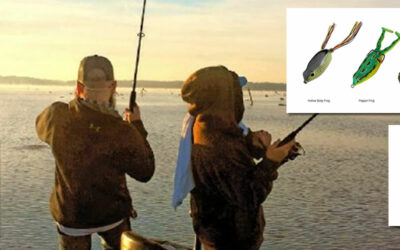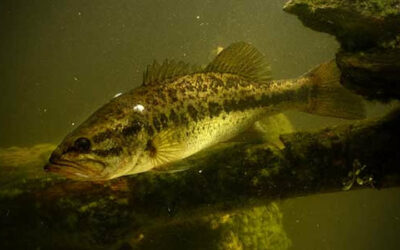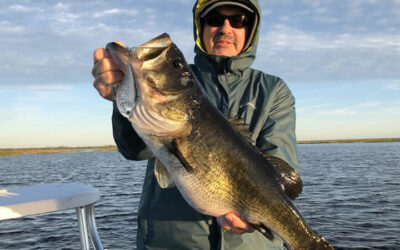Bass can be found in various environments, from small farm ponds to large lakes, babbling brooks to raging rivers. Throughout much of the southeastern United States, one of the more famous locales, Bass, can be found in its rivers. Bass fishing in rivers provides a premier hunting habitat with miles of waterways to explore, making it a bass paradise and a primetime opportunity for anglers.
River fishing for bass it’s not only an entertaining way to angle, but it also tends to yield a solid crop of bass. Whether you cast from the bank or work shorelines from a boat, bass anglers can put their fishing skills to the test against smallmouth bass and largemouth bass in most rivers in the southeastern United States and as far west as California. This article covers where to go bass fishing in rivers and some bait, techniques, and fishing tips to make your angling experience a great one.
River Bass Fishing Locations
In larger rivers, there are more opportunities for locating fish as the varying current and water levels provide many possible locations for hungry bass. Fishermen should search for the perfect combination of cover, current, and depth; the river will hold fish at this crossroads.
Transitions
Transitions are always an excellent place to locate fish. Current breaks, drop-offs, undercut banks, and the line between shade and sunlight are all prime locations for bass to ambush prey. Instead of casting across these transitions, anglers should look to work its perimeter, attempting to lure out a largemouth watching the surface.
Occasionally, a river will carve out a portion of the bank to create a safe harbor out of the current. These spaces of slow or dead water just outside the river’s main flow allow the bass to search the current from the shelter of the river bank, making bank fishing very productive at times.
Combo
Contrary to popular belief, large bass doesn’t always head to deep water. When selecting a hideout, these ambush predators look for a combination of cover, flowing water, and food sources. Because the river brings food to the bass, many sit in pockets on the downstream side of an underwater structure to escape the current.
Off the Beaten Path
If you have trouble finding fish on the main river, concentrate on backwater areas where the flow is reduced. These pockets of deeper water or offshoot creeks often hold monsters that avoid feeding in the main river. Instead, this large bass waits for smaller fish, large insects, amphibians, baby birds, or even small mammals that fall into or cross their lair.
If you’re angling in the backwaters, find out-of-the-way locations to fish. That run-off or slow-moving creek that feeds into the main river, the rootball providing cover, and the shoal bass might be sunning themselves in are all perfect opportunities to cast your lure into and draw out a subsurface monster.
Cover
The cover is king, so locating structure is imperative to prevent snags and locate potential ambush sites for a lunker. Examples of cover include sparse boulders, partially submerged drains, fallen trees, submerged rocks, and rootballs, all attracting bass, providing a sanctum from which these fish can ambush their prey while hiding from predators.
When you catch bass at these sites, try to minimize the disturbance you create. Quality ambush sites usually hold more than one fish, so an angler is bass fishing in Rivers. They can catch many river bass without changing spots from boats or land and finding a new fishing hole.
RIVER FISHING TIPS
Every veteran angler has their fishing tips, an unwritten rule book of angling knowledge learned the hard way.
Think Like a Bass
When observing a river for the first time, before casting into it, take a second to take stock of your surroundings. Observe the cover, submerged terrain, water quality, current, and depth. Factoring in all of these things, where would you most likely stage an ambush on unsuspecting prey?
Water Color Matters
Smallmouth bass prefers deep, clearer water over sandy or rocky bottoms with a stiff current and are often found at depths of 25 feet or more. Largemouth bass prefers stained, shallower water where they can quickly strike unsuspecting prey on the surface.
Seasonal Fishing
Spring and summer bass prefer the shoreline during the morning and the deeper water during the sun’s zenith. Topwaters and spoons tend to have high returns from early spring through late summer when bass fishing in a river. During the fall and winter months, the bite is slower. Bass stick to the deep pools until the sun warms the shallows, making noon one of the best times to angle for river bass.
Keep it Natural
Most people think the flashiest, brightest, and noisiest lures have the highest success rate with river bass. While it does pay to stand out, in most situations, the best lures resemble naturally occurring sources of food on the river. Plastic lizards, crawfish, shad, worms, or frogs ranging from a dull silver to pumpkin seed or watermelon are incredibly successful in river fishing for bass.
Outside the Box
When bass fishing in rivers, they don’t always respond well to plastics, leaving many anglers confused about their go-to bait falling flat. Years ago, on the Bogue Chitto River, I caught my first bass on a Carolina rig baited with worms while angling for catfish. Sometimes, natural baits such as worms, minnows, crawfish, and crickets can unlock the jar of a tight-mouthed bass when plastics fail.
Size Matters
Bigger doesn’t always mean better. Large top waters, crankbaits, jigs, and tube baits don’t necessarily guarantee larger bass, but they ensure that smaller bass may avoid them, viewing these sizeable plastics as outside their food chain. Small to medium size plastics yield the best results when river fishing for bass.
Bait
All rivers are not the same. Each body of water has its unique ecosystem founded on a food chain that can differ by state, county, or even portion of the river. Because of this, anglers should do some homework to find out what bass in this portion of the river is feeding on.
Factors to Consider
The choice of bait and lures can also be affected by the seasons. Insects, reptiles, and certain fish may be a staple to a bass’s diet during the summer but yield zero results during the winter. This is why anglers need to select a seasonally appropriate lure.
River bass is opportunistic hunters who rely on the current to feed them. Because of this, it’s essential that the lure or bait cast out doesn’t spook them.
Species can also play a big role in role in lure selection. Smallmouth bass prefers deeper, clear water over a rock or sand-strewn bottom and usually respond well to crank or dive baits. Note: Smallmouth bass often share a habitat with trout and, in select cases, have even been caught on the same bait.
Triple C
When it comes to selecting a bait to angle for bass in a river, there are three rules I use to determine the right lure,
Current
Is it fast-moving, is it deep, and does it change speeds?
Conditions
What are the light conditions, temperature, water quality, time of year, and food chain?
Cover
What kind of cover does the river have? Trees, rocks, logs, grass, reeds, rootballs, alcoves, etc.
Commonly Used Lures
Popular lures when bass fishing in a river include
- Plastic lizards/worms
- Gold Spoons (Both)
- Topwater Frog (Largemouth)
- Deep Diving Crankbait (Smallmouth)
- Tube Bait (Smallmouth)
RIVER FISHING TECHNIQUES
Once you know what freshwater tackle and bait to buy and can locate the best bass fishing in rivers and the good spots on the river, it’s time to get your hook wet. The following are techniques that bass anglers looking to catch fish on rivers should incorporate to ensure they come back with a full stringer.
-
Cast upstream
In many cases casting upstream means that your lure or bait moves in conjunction with the current and other prey in the river’s ecosystem. The water flow will carry your bait downstream, past all the good spots previously referenced. If the bait is not drug directly into a fish’s hiding spot, some bass follows it into the current and chase it down.
-
Cast Downstream
Casting downstream means that your abatement work against the current, creating a disturbance that will alert bass to “struggling prey.” Casting to the downstream side also means that the bait will be in the water longer than casting upstream, leaving it to hang in the water column a little longer.
-
Work Cover
Whenever you hit a river to go bass fishing, one of the first things to do is locate cover. If a submerged structure creates a disturbance in the current, it’s a safe bet that bass lurks under it or just downstream. Whether it’s throwing under an overhanging tree, an undercut bank, or next to a submerged log, work cover.
-
Distress
Ambush predators like river bass love distressed and struggling prey. Lures and bait that mimic this are favorites of bass anglers as they have a high success rate when river fishing. Top water and crank baits that imitate distressed fish or amphibians are favorites.
-
Boat
Boats provide a form of angling on the river unattainable by the shore. The mobility to navigate the parts of the river or creek unreachable by land is a benefit for sure, but the true beauty of a boat is its ability to work a shoreline.
Anglers can troll or paddle up and down a single stretch of shoreline against the current, casting various baits without alerting the fish to the rod holder’s presence.
Bass fishing in rivers can be an enjoyable experience for anglers of all skill levels. Filling up a stringer can be as simple as knowing what to look for in a good fishing hole on the river, but selecting the right lures and paying attention to the triple C can also make a huge difference. Good luck, and stay safe.











Hi ,I have recently moved to the Lake Parrish area in Florida . I have previously fished for Bass and other fish in my hometown (Toronto Canada ) Perhaps off topic ,but are their any fishing clubs in this area . as I would like to get involved as I have plenty of time to //volunteer and help and do my fishing as well If anybody out there knows of any angling clubs /i would appreciate any info Many ?Thanks Peter G/.
Hi Peter, thanks for the comment. Here’s a great list of fishing clubs https://bassonline.com/florida-fishing-clubs/